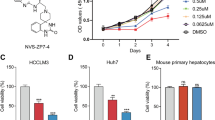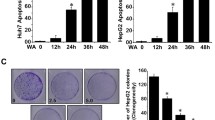Abstract
Hepatocellular carcinoma (HCC) is the fifth most common cancer worldwide and is the third most common cause of cancer-related deaths. Currently available treatment options for HCC patients are scarce resulting in an urgent need to develop a novel effective cure. Polygonum capitatum is a medicinal herb which has been used to treat inflammatory diseases in Miao nationality of China. We recently isolated a pure compound davidiin from P. capitatum extract. Four HCC cell lines were treated with davidiin. Cell viability was recorded by MTT assay. siRNAs targeting enhancer of zeste homolog 2 (EZH2) were applied to modulate the expression of EZH2. Established xenograft mice models of HCC were applied to evaluate the in vivo anticancer activity of davidiin. We investigated the anticancer activity and the underlying mechanism of davidiin. The compound inhibited HCC cell growth and also suppressed tumor growth in xenografted HCC mouse. Such inhibition was facilitated by specifically downregulation on EZH2. The compound possesses anticancer activity both in vitro and in vivo which warrants further clinical investigation as a potential anti-HCC agent.



Similar content being viewed by others
Abbreviations
- Bmi-1:
-
B lymphoma Mo-MLV insertion region 1 homolog
- CBX:
-
Chromobox protein homologue
- DMSO:
-
Dimethylsulfoxide
- EDTA:
-
Ethylenediaminetetraacetic acid
- EED:
-
Embryonic ectoderm development
- EZH2:
-
Enhancer of zeste homolog 2
- GAPDH:
-
Glyceraldehyde 3-phosphate dehydrogenase
- HCC:
-
Hepatocellular carcinoma
- HRP:
-
Horseradish peroxidase
- H3K27me3:
-
Histone H3 trimethylated on lysine 27
- MG132:
-
N-(benzyloxycarbonyl)leucinylleucinylleucinal Z-Leu-Leu-Leu-al
- MTT:
-
3-(4,5-Dimethylthiazol-2-yl)-2,5-diphenyltetrazolium bromide
- PARP:
-
Poly ADP ribose polymerase
- PcG protein:
-
Polycomb group protein
- PCR:
-
Polymerase chain reaction
- PH:
-
Polyhomeotic
- PI:
-
propidium iodide
- PRC:
-
Polycomb repressor complex
- PVDF:
-
Polyvinylidene difluoride
- RBAP48:
-
Retinoblastoma-binding protein p48
- SFN:
-
Sulforaphane
- SUZ12:
-
Suppressor of zeste 12
- TCM:
-
Traditional Chinese medicine
- TUNEL:
-
Terminal deoxynucleotidyl transferase dUTP nick end labeling
References
Parkin DM. Global cancer statistics in the year 2000. Lancet Oncol. 2001;2:533–43.
He J, Gu D, Wu X, Reynolds K, Duan X, Yao C, et al. Major causes of death among men and women in China. N Engl J Med. 2005;353:1124–34.
Cao H, Phan H, Yang LX. Improved chemotherapy for hepatocellular carcinoma. Anticancer Res. 2012;32:1379–86.
Lam W, Bussom S, Guan F, Jiang Z, Zhang W, Gullen EA, et al. The four-herb Chinese medicine PHY906 reduces chemotherapy-induced gastrointestinal toxicity. Sci Transl Med. 2010;2:45–59.
Song LR, Ding XL, Zang ZY, Hong X. Dictionary of modern TCD. 1st ed. Beijing: People’s Medical Publishing House; 2001. p. 580–1.
Orlando V. Polycomb, epigenomes, and control of cell identity. Cell. 2003;112:599–606.
Caldas C, Aparicio S. Cell memory and cancer—the story of the trithorax and Polycomb group genes. Cancer Metastasis Rev. 1999;18:313–29.
LaTulippe E, Satagopan J, Smith A, Scher H, Scardino P, Reuter V, et al. Comprehensive gene expression analysis of prostate cancer reveals distinct transcriptional programs associated with metastatic disease. Cancer Res. 2002;62:4499–506.
Varambally S, Dhanasekaran SM, Zhou M, Barrette TR, Kumar-Sinha C, Sanda MG, et al. The polycomb group protein EZH2 is involved in progression of prostate cancer. Nature. 2002;419:624–9.
Dimri GP, Martinez JL, Jacobs JJ, Keblusek P, Itahana K, Van Lohuizen M, et al. The Bmi-1 oncogene induces telomerase activity and immortalizes human mammary epithelial cells. Cancer Res. 2002;62:4736–45.
Simon JA, Kingston RE. Mechanisms of Polycomb gene silencing: knowns and unknowns. Nat Rev Mol Cell Biol. 2009;10:697–708.
Kuzmichev A, Nishioka K, Erdjument-Bromage H, Tempst P, Reinberg D. Histone methyltransferase activity associated with a human multiprotein complex containing the enhancer of zeste protein. Genes Dev. 2002;16:2893–905.
Cao R, Wang L, Wang H, Xia L, Erdjument-Bromage H, Tempst P, et al. Role of histone H3 lysine 27 methylation in polycomb-group silencing. Science. 2002;298:1039–43.
Zeidler M, Kleer CG. The Polycomb group protein enhancer of zeste 2: its links to DNA repair and breast cancer. J Mol Histol. 2006;37:219–23.
Sudo T, Utsunomiya T, Mimori K, Nagahara H, Ogawa K, Inoue H, et al. Clinicopathological significance of EZH2 mRNA expression in patients with hepatocellular carcinoma. Br J Cancer. 2005;92:1754–8.
Steele JC, Torr EE, Noakes KL, Kalk E, Moss PA, Reynolds GM, et al. The polycomb group proteins, BMI-1 and EZH2, are tumour-associated antigens. Br J Cancer. 2006;95:1202–11.
Chen Y, Lin MC, Wang H, Chan CY, Jiang L, Ngai SM, et al. Proteomic analysis of EZH2 downstream target proteins in hepatocellular carcinoma. Proteomics. 2007;7:3097–104.
Balasubramanian S, Chew YC, Eckert RL. Sulforaphane suppresses polycomb group protein level via a proteasome-dependent mechanism in skin cancer cells. Mol Pharmacol. 2011;80:870–8.
Choudhury SR, Balasubramanian S, Chew YC, Han B, Marquez VE, Eckert RL. (−)-Epigallocatechin-3-gallate and DZNep reduce polycomb protein level via a proteasome-dependent mechanism in skin cancer cells. Carcinogenesis. 2011;32:1525–32.
Fu J, Ma JY, Zhang XF, Wang Y, Feng R, Chen YC, et al. Identification of metabolites of davidiin, a potential antitumor ellagitannin, transformed by rat intestinal bacteria in vitro, based on liquid chromatography–ion trap–time of flight mass spectrometry analysis. J Pharm Biomed Anal. 2012;71:162–7.
Pfaffl MW. A new mathematical model for relative quantification in real-time RT-PCR. Nucleic Acids Res. 2001;29:45.
Han YH, Moon HJ, You BR, Park WH. The effect of MG132, a proteasome inhibitor on HeLa cells in relation to cell growth, reactive oxygen species and GSH. Oncol Rep. 2009;22:215–21.
Liao SG, Zhang LJ, Sun F, Zhang JJ, Chen AY, Lan YY, et al. Antibacterial and anti-inflammatory effects of extracts and fractions from Polygonum capitatum. J Ethnopharmacol. 2011;134:1006–9.
Kleer CG, Cao Q, Varambally S, Shen R, Ota I, Tomlins SA, et al. EZH2 is a marker of aggressive breast cancer and promotes neoplastic transformation of breast epithelial cells. Proc Natl Acad Sci USA. 2003;100:11606–11.
Lee K, Adhikary G, Balasubramanian S, Gopalakrishnan R, McCormick T, Dimri GP, et al. Expression of Bmi-1 in epidermis enhances cell survival by altering cell cycle regulatory protein expression and inhibiting apoptosis. J Invest Dermatol. 2008;128:9–17.
Tan J, Yang X, Zhuang L, Jiang X, Chen W, Lee PL. Pharmacologic disruption of polycomb-repressive complex 2-mediated gene repression selectively induces apoptosis in cancer cells. Genes Dev. 2007;21:1050–63.
Acknowledgments
This work was supported by grants from the Research Grants Council General Research Fund of Hong Kong [CUHK462109 and CUHK462211], National Natural Science Foundation of China [81101888], Shenzhen Basic Research Program [JC201105201092A], Direct Grant from CUHK to YC, NSFC grant [81072611], National Science and Technology Special Projects [2012ZX09301002-006], and the Special Fund of Chinese Central Government for Basic Scientific Research Operations [2012CHX08] to YW.
Conflicts of interest
None
Author information
Authors and Affiliations
Corresponding author
Electronic supplementary material
Below is the link to the electronic supplementary material.
Open Resource
Statistical analysis of western blots shown in Figs. 1e and 2a, c. (a) Reduced caspase 3 level and increase in both PARP and caspase 3 cleavages were detected in both Hep3B and Bel7404 cells treated with davidiin. (b) Reduced the levels of EZH2, H3K27me3, and cyclin D1 were observed when Hep3B and Bel7404 were treated with davidiin. (c) Davidiin-induced EZH2 reduction was reversed by MG132, when davidiin-treated HCC cells were co-treated with a proteasome inhibitor, MG132. Transcript levels between groups were considered as significantly different when p < 0.05 (*p < 0.05, **p < 0.01 vs. control, n = 3) (PDF 351 kb)
Rights and permissions
About this article
Cite this article
Wang, Y., Ma, J., Chow, S.C. et al. A potential antitumor ellagitannin, davidiin, inhibited hepatocellular tumor growth by targeting EZH2. Tumor Biol. 35, 205–212 (2014). https://doi.org/10.1007/s13277-013-1025-3
Received:
Accepted:
Published:
Issue Date:
DOI: https://doi.org/10.1007/s13277-013-1025-3




